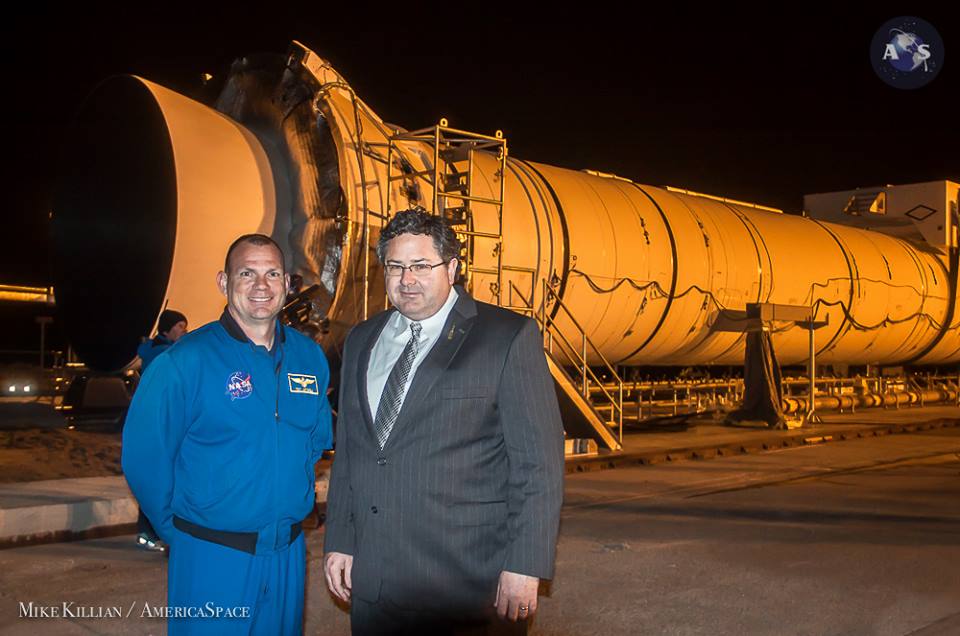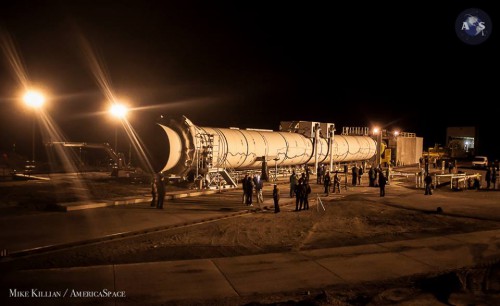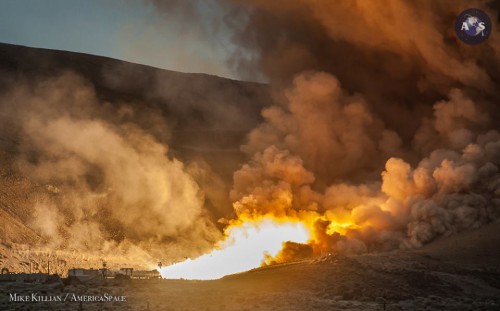
The solid rocket booster that will propel NASA’s skyscraper-size Space Launch System (SLS) rocket and its Orion crews on deep space missions in the coming years took a huge step forward in its development on Wednesday, March 11, 2015, unleashing its fury on a barren mountainside at Orbital ATK’s test stand in Promontory, Utah, for the Qualification Motor-1 test fire (QM-1). The 154-foot-long booster, the largest of its kind in the world, was tested to verify its performance at the highest end of the booster’s accepted propellant temperature range—90 degrees—a temperature the SLS can expect to encounter on a regular basis at its Florida launch site on Kennedy Space Center (KSC) Launch Complex 39B.
“This motor firing is the first of two qualification tests to certify the motor configuration for NASA’s Space Launch System,” said Charlie Precourt, Vice President and General Manager of Orbital ATK’s Propulsion Systems Division, and four-time space shuttle astronaut. “The data from today and from our three development motor tests, along with information we have collected on hundreds of predecessor motors over the past three decades, confirms this is the most capable and powerful solid rocket motor ever designed.”

It took only a second for the booster to reach 3.6 million pounds of thrust (equivalent to 22 million horsepower), burning through 5.5 tons of propellant per second, at 5,000 degrees Fahrenheit, for just over two minutes—exactly as it will when it launches the SLS.
Initially it appears that the test fire was a complete success, with data pouring in almost immediately after the booster burned dry. More than 500 instrumentation channels were used to help evaluate over 100 defined test objectives, and newly designed avionics hardware and equipment to control the motor helped provide improved test monitoring capability.
The test also demonstrated the booster’s ability to meet applicable ballistic performance requirements, such as thrust and pressure. Other objectives included data gathering on vital motor upgrades, such as the new internal motor insulation and liner and an improved nozzle design.
According to Orbital ATK, “other test improvements include a new main pivot flexure design in the forward thrust block to transfer the massive forces from the test into the various load cells for thrust monitoring, as well as an added mid-span support that assisted in adjusting the motor centerline to make the test more consistent with actual flight conditions.”
“This test is a significant milestone for SLS and follows years of development,” said Todd May, SLS program manager. “Our partnership with Orbital ATK and more than 500 suppliers across the country is keeping us on the path to building the most powerful rocket in the world.”
The five-segment solid rocket booster has been in development for years, having been initially designed to launch NASA’s Ares rockets for the agency’s cancelled Constellation program. The booster is similar to the four-segment SRBs that helped launch the space shuttle fleet, but it’s larger and incorporates several upgrades and improvements. Now, after a lengthy investigation and trouble-shooting effort to determine root cause(s) and corrective actions for the existence of small voids previously discovered between the propellant and outer casing of the booster’s aft segment, Orbital ATK is back on track with the booster’s development and already constructing the hardware for a second test fire next year.
Three fully developed, five-segment SRBs have been fired up on Orbital ATK’s Promontory, Utah, T-97 test stand since 2009, with the most recent having been conducted in 2011, and all performed fine. Those tests, known as the Development Motor test series (DM-1, DM-2, and DM-3), helped engineers measure the new SRB’s performance at low temperature, verify design requirements of new materials in the motor joints, and gather performance data about upgrades made to the booster since the space shuttle program.

Once ignited the five-segment SLS booster will deliver an incredible 3.6 million pounds of thrust, which is equivalent to 22 million horsepower—each—and the SLS will employ two of the 1.6 million pound boosters to help NASA’s future deep-space crew missions escape the pull of Earth’s gravity to reach destinations such as an asteroid and, eventually, Mars. The five-segment SLS boosters will burn for the same amount of time as the old shuttle boosters—two minutes—but they will provide 20 percent more power, while also providing more than 75 percent of the thrust needed for the rocket to escape the gravitational pull of the Earth.
To help put the power of Orbital ATK’s five-segment SRB into perspective, consider this: If the heat energy of the booster could be converted to electric power, the two SRBs firing for two minutes would produce 2.3 million kilowatt hours of power, enough to supply the entire power demand of over 92,000 homes for a full day.

With the QM-1 test now complete a post-fire disassembly inspection is underway. It will take approximately six weeks to disassemble and remove the QM-1 booster from the test stand, and detailed inspections will take another several months.
A cold-temperature test, at a target of 40 degrees Fahrenheit, the low end of the propellant temperature range, is planned for spring 2016 (Qualification Motor-2 / QM-2) before the hardware testing to support qualification of the boosters will be complete, at which point they will then be ready to proceed toward the first flight of SLS, an uncrewed flight to validate the entire integrated system, currently scheduled to fly on the Exploration Mission-1 (EM-1) in late 2018.
“The work being done around the country today to build SLS is laying a solid foundation for future exploration missions, and these missions will enable us to pioneer far into the solar system,” said William Gerstenmaier, NASA’s associate administrator for human exploration and operations. “The teams are doing tremendous work to develop what will be a national asset for human exploration and potential science missions.”
Although the boosters themselves will provide 75 percent of the power needed to break Earth’s hold, the SLS will still employ four engines of its own—former (upgraded) liquid-fueled space shuttle RS-25 engines—which are currently at NASA’s Stennis Space Center preparing for their own series of tests, the first of which occurred earlier this year. A second RS-25 test fire is currently scheduled for May or June this year.
“This is an exciting time for exploration, as we venture farther into space,” added Precourt. “The promise of deep space exploration will inspire the next generation to pursue careers in science, technology, engineering and math – preparing them to run the missions we’re designing.”
BELOW: Photos from our coverage of the QM-1 test fire March 11, 2015, at Orbital ATK’s testing grounds in Promontory, Utah. All photos credit Mike Killian and John Studwell for AmericaSpace, all rights reserved.
– Want to keep up-to-date with all things space? Be sure to “Like” AmericaSpace on Facebook and follow us on Twitter: @AmericaSpace
Missions » SLS » Missions » SLS » QM-1 »




















The article says 5,000 lbs of propellant per second and 3.6 million pounds of thrust. That would be an Isp of 720 if true, which of course it can’t be. What is the actual propellant burned per second, or the actual Isp so I can figure it for myself?
John, this was an error on my part, I spoke with the gentlemen who mixes the propellant myself, in his mixing facility, & misunderstood tons for pounds.
The five-segment booster burns 5.5 tons, or 11,000 pounds, per second, not 5,000 pounds per second.
It seems a waste the SLS only uses two of these boosters. If we are going to build a launch vehicle to enable deep space human operations then we should get as much lift as possible- four of these would be more appropriate- and a core stage using RS-68A’s. The decision to use the less powerful RS-25E was “necessary” due to existing design features that could have been changed. As a boy in the 60’s I had a time life book titled “Man in Space” and it featured an illustration of just such a 4 booster launch vehicle.
I agree. Four standard four segment boosters well tested in the shuttle program along with known RS68s could have been boosting a stretched ET years ago with more payload than the baseline SLS.
John Hare: Two other sites are saying 5.5 tons per second which would be 11,000 pounds. Does that work out to a more realistic Isp number?
I’ve corrected the error after speaking with Orbital ATK this morning, I spoke with the gentleman who mixes the propellant myself the other day & mixed up tons for pounds in my numbers. The booster burns 5.5 tons per second, not 5k pounds per second. Story updated
Scott Smith,
Still high for a solid at sea level. 327 second Isp is considerably higher than the solids I am aware of. Even if the 5.5 tons is metric the Isp would be almost 300. I would expect the mid 200s for a real world solid.
The only thing I see that could make it work is if the 3.6 million pounds thrust is peak at lift off, while the 5.5 tons is average across the total burn including the lower thrust on the last half for acceleration control.
Thanks Mike, wasn’t trying to bust chops, just numbers oriented.
My wife Karen and I attended the QM-1 test. Congratulations to the teams at Orbital ATK and NASA on a job well done!